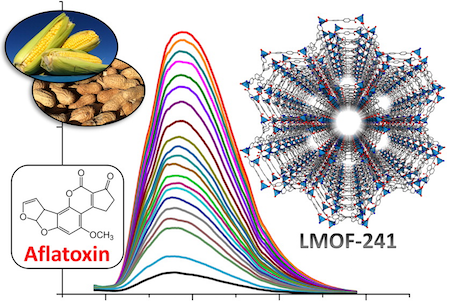Mycotoxins—toxic chemical products produced by fungi—contaminate 25% of global food crops, leading to the loss of 1 billion metric tons of food products annually. Although current mycotoxin detection methods are effective, they are also expensive and require complex sample preparation. Researchers from Rutgers University, Northern Illinois University, and the Advanced Light Source (ALS) have designed and synthesized a new luminescent metal–organic framework, LMOF-241, which is able to selectively detect a widespread and potent mycotoxin, Aflatoxin B1, readily and cost effectively at the parts per billion level, making it the most sensitive luminescence-based detector. In addition, it has the highest luminescence quantum efficiency of all green-emitting MOFs report to date.
After synthesizing LMOF-241 crystals, the team used the ALS Chemical Crystallography Beamline, 11.3.1, to collect single-crystal diffraction data. The results provided precise information on the structure’s topology, chemical bonding, and porosity. The crystal structure data also enabled the researchers to perform molecular orbital calculations on the LMOF to understand and propose an electron transfer mechanism between the LMOF and Alfatoxin B1 that they believe is responsible for the sensing interaction. In addition, the team was able to simulate the adsorption of the mycotoxin into the LMOF pores, which they used to quantify the LMOF–mycotoxin interactions and explain the selectivity of the system.
The results indicate that LMOFs have immense potential as simple, low-cost, portable, and readily available luminescence-based sensors for the detection of mycotoxins and other biochemical hazards.

Work performed at ALS Beamline 11.3.1.
Zhichao Hu, William P. Lustig, Jingming Zhang, Chong Zheng, Hao Wang, Simon J. Teat, Qihan Gong, Nathan D. Rudd, and Jing Li. “Effective detection of mycotoxins by a highly luminescent metal–organic framework,” J. Am. Chem. Soc. 137, 16209 (2015).